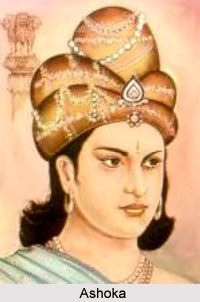 The Mauryan Empire was the first major empire in the history of India that had ruled the land from 322 B.C. to 185 B.C. The Mauryan Empire had scaled considerable heights under the legendary Mauryan kings Chandragupta Maurya, Bindusara and Ashoka. During the eventful and glorious span of these kings, the Mauryan Empire had extended to vast limits and had attained unprecedented success in the fields of art, architecture etc. Mauryan Empire was perhaps the largest empire ever to have ruled the Indian subcontinent. Under Chandragupta and his successors, both internal and external trade, agriculture and economic activities- everything had achieved thriving properity and expanded across India. The Mauryan emperor had established a system of finance, administration and security, which led to proper socio-economic and civil life during the Mauryan kings. During the glorious reign of the Mauryan monarchs, India had a prosperous and stable empire with economic and military power, whose political influence and trade extended across West and Central Asia and Europe. Mauryan India also enjoyed an era of social harmony, religious transformation and expansion of sciences and knowledge. However the famous kings of Mauryan lineage under whom India made unprecedented progress, was the founder king Chandragupta Maurya and his sucessors Bindusara and Ashoka.
The Mauryan Empire was the first major empire in the history of India that had ruled the land from 322 B.C. to 185 B.C. The Mauryan Empire had scaled considerable heights under the legendary Mauryan kings Chandragupta Maurya, Bindusara and Ashoka. During the eventful and glorious span of these kings, the Mauryan Empire had extended to vast limits and had attained unprecedented success in the fields of art, architecture etc. Mauryan Empire was perhaps the largest empire ever to have ruled the Indian subcontinent. Under Chandragupta and his successors, both internal and external trade, agriculture and economic activities- everything had achieved thriving properity and expanded across India. The Mauryan emperor had established a system of finance, administration and security, which led to proper socio-economic and civil life during the Mauryan kings. During the glorious reign of the Mauryan monarchs, India had a prosperous and stable empire with economic and military power, whose political influence and trade extended across West and Central Asia and Europe. Mauryan India also enjoyed an era of social harmony, religious transformation and expansion of sciences and knowledge. However the famous kings of Mauryan lineage under whom India made unprecedented progress, was the founder king Chandragupta Maurya and his sucessors Bindusara and Ashoka.
Chandragupta Maurya - Chandragupta Maurya was the founder king of the Mauryan dynasty. His origin and ancestry is still unknown. Yet historians have opined that he had appeared in the political scenario of India during the invasion of Alexander and liberated India from the Macedonians. Chandragupta Maurya had extended the Mauryan kingdom through his enormous conquests to the trans-Indus region, which was under Macedonian rule and also in major parts of India.
Bindusara - Bindusara was the immediate successor of Chandragupta Maurya. About the early life of Bindusara it is known that he was the son of Chandragupta by a woman named Durdhara. Bindusara had inherited a vast kingdom from his father, which he had extended to the southern part, as far as what is now known as Karnataka. He had brought sixteen states under the Mauryan Empire and had thus conquered almost all the Indian peninsula. Bindusara was titled "Amitraghata" because he had conquered "the land between two seas".
Ashoka, the great - Ashoka was the greatest ruler of the Mauryan dynasty. Though much is not known about the early life and career of Ashoka, it is however pointed out by historians that he had ascended the throne after becoming victorious in the civil war. His Empire constituted major parts of present India. Such a mighty conqueror shunned the desire for conquest after witnessing the huge massacre of Kalinga War and embraced Buddhism. His rock edicts were important sources about his reign and policies that he had adopted and at the same time were rare architectural pieces.



















